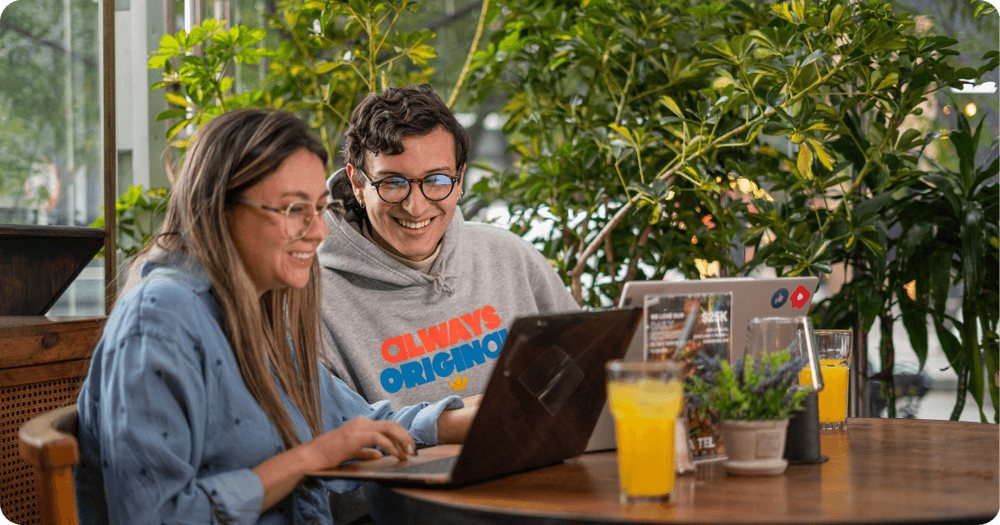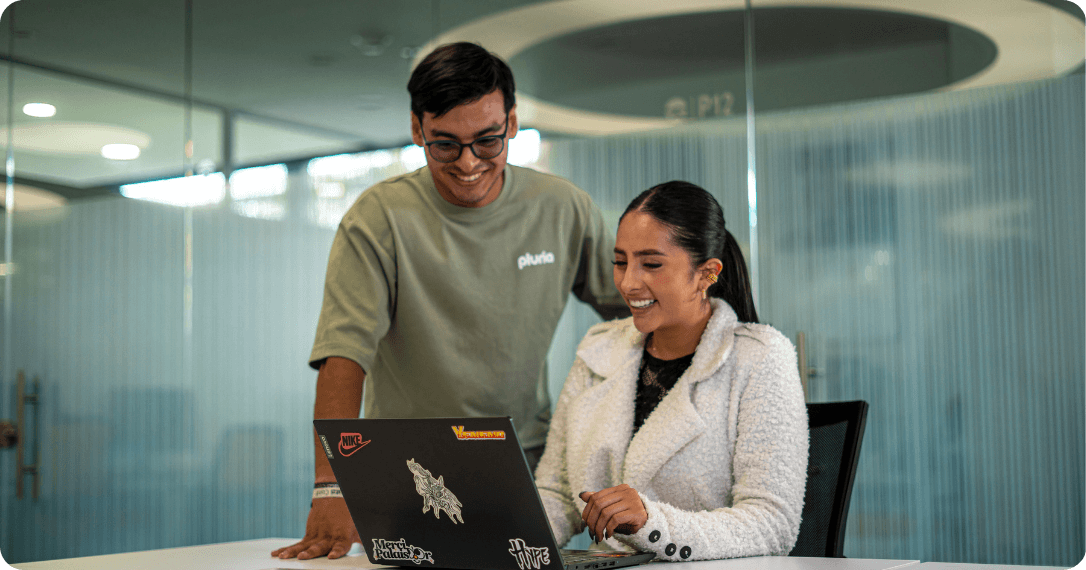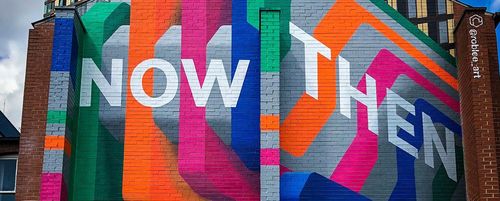

How to Improve Team Collaboration and Get Real Work Done

19 May, 2025
Share this article
If team collaboration means replying to 27 Slack threads and still not knowing who’s doing what, you’re not alone.
Switching from a traditional way of working to a fully remote one wasn’t easy for me. I missed my colleagues, the quick coffee chats, even the background noise of the office. At the same time, I loved the flexibility. Working from anywhere, on my own schedule, with fewer distractions. What was harder was figuring out how to stay in sync with my team while working from different places and improve collaboration in a remote setup.
Collaboration isn’t about more meetings or noisy group chats. It’s about clarity, trust, and working toward the same goal. Some teams sit together in an office. Others are spread across time zones. The basics are the same.
Real collaboration means people understand their roles, share feedback, and help each other move forward. It doesn’t mean everything goes smoothly all the time. But when teams know how to work through the messy parts, that’s when the real progress happens.
This is not about buzzwords or theory. It’s a practical look at how to work better together with the right tools, clear goals, and a bit more intention.

The benefits of team collaboration and why it matters in the workplace
When team collaboration works, everything else runs smoother. Projects move faster, ideas get better, and people feel more connected. It’s not just about efficiency. It’s about building something stronger together.
Good collaboration creates alignment. Everyone knows the goal, understands their role, and sees how their work fits into the bigger picture. That kind of clarity helps teams move in the same direction, even when the work is complex or the pressure is high. It also cuts down on confusion, with fewer missteps, less duplicated effort, and more time for real problem-solving.
But the real value goes deeper. When people collaborate well, they feel heard and respected. They speak up more, take ownership, and care about what they’re building. That’s what keeps motivation going over time. Not just perks or bonuses, but the sense that your work matters and your team has your back.
In hybrid or remote setups, collaboration matters even more. You don’t have hallway chats or quick catch-ups. So you need clear structure, better habits, and tools that support real connection.
Here’s why it matters:
- It creates clarity. People know what they’re doing, why it matters, and who’s doing what.
- It boosts engagement. People feel included and committed.
- It keeps remote teams connected. Good habits and the right tools help everyone stay in sync.
- It drives better outcomes. Teams in a collaborative environment move faster, solve smarter, and stay ahead.
Strong collaboration is not an extra. It’s the foundation for doing great work, together.

Start with clear goals, roles, and expectations
Great teamwork starts with knowing who’s doing what and why. Clear direction gives everyone space to focus and contribute. It prevents confusion, missed deadlines, and frustration, especially in remote or cross-functional teams.
Without clear goals, people tend to pull in different directions. Even the most talented team can get stuck if no one knows what the priorities are. That’s why alignment needs to happen early. Not just on tasks, but on what success looks like and how to get there.
The same goes for roles. Everyone should understand their responsibilities, how decisions are made, and who is leading what. This avoids micromanagement and the kind of gaps where things fall through. It also supports effective team collaboration by giving each person clear responsibility and also builds trust. When people know what’s expected of them and what’s not, they can focus on doing their part well.
Remote and hybrid teams feel this even more. Without daily check-ins or quick hallway chats, unclear direction turns into chaos fast. It’s better to communicate too much up front than to clean up later.
Here’s what makes a difference:
- Define the common goal. Everyone should know what they’re working toward.
- Clarify roles and ownership. People need to know their lane and how it connects to the rest.
- Set expectations early. Be specific about deliverables, deadlines, and how progress will be tracked.
- Revisit and adjust. Priorities shift. Keep the conversation going.
Clear direction is not about control. It’s what gives teams the freedom to do great work.

Building team collaboration: use the right tools
No tool can fix a broken process. But the right setup can make everything easier. Shared docs, task boards, async messaging. Keep it simple and useful. Tech should support the work, not get in the way.
The best tools are the ones your team actually uses. It’s not about having the most features. It’s about creating clear workflows and making communication easy. When tools are clunky or all over the place, people start defaulting to side chats or working in silos. That slows everything down.
Choose the team collaboration tools that match how your team works. If most of your work happens async, focus on documentation and flexible task management. If real-time coordination matters more, chat and video will play a bigger role. And don’t overdo it. Too many platforms lead to confusion, not clarity.
What matters most is that everyone uses the same setup the same way. Create a few shared rules. Update them when things change.
Here’s what helps:
- Pick tools that match your workflow. Choose what fits how your team actually works.
- Keep it simple. Fewer tools, used well, beat a long list no one follows.
- Prioritize async when possible. This gives everyone space to focus and stay productive.
- Set shared rules. Make sure people know where to find updates and how to stay aligned.
The right team collaboration tools won’t fix everything, but they reduce friction and support clarity.

Build trust through communication and feedback
Teams work better when people feel safe to speak up. That means making room for honest feedback, regular check-ins, and small acts of trust. Collaboration is human. Treat it that way.
Trust doesn’t happen all at once, and it’s not something you can fix with a team-building day. It grows in everyday moments. In how you listen. In how you respond. In how you show up for each other. When people know their voice matters, they’re more likely to contribute, flag problems early, and take real ownership. That’s the foundation of any effective team collaboration.
Set the tone. A respectful, collaborative environment starts with leadership.
Open communication makes that possible. Not constant updates or forced sharing, but real conversations that go both ways. Ask for input. Give feedback with care. When things go wrong—and they will—trust helps your team recover instead of shut down.
In remote and hybrid teams, this matters even more. It’s easier to misread silence or assume the worst. A short message like “thanks for jumping in” or “that idea really helped” can go a long way.
What builds trust:
- Make it easy to speak up. People should feel safe sharing ideas or concerns.
- Give and ask for feedback. Keep it part of the daily routine, not just formal reviews.
- Notice effort. A little appreciation builds connection fast.
- Set the tone. How you lead and listen shapes the whole team.
You can’t fake trust. But you can build it, step by step. And when it’s there, collaboration becomes a lot easier.

Handle conflict without letting it derail progress
Conflict isn’t a red flag. It’s part of working with other humans. And if you know how to handle it, it can actually move your team forward.
Disagreements will happen. People have different styles, priorities, and opinions. That’s not a problem. In fact, it often leads to better ideas and stronger results. But only if your team knows how to manage the friction without shutting down or turning against each other.
The goal isn’t to avoid conflict. It’s to deal with it with respect. That means slowing down when things get tense, asking questions instead of making assumptions, and leaving egos out of it. Most of the time, conflict isn’t about who’s right. It’s about how to move forward without losing trust.
It helps to build a culture where healthy disagreement is okay. Where people can challenge ideas without worrying about backlash. That kind of openness makes collaboration more honest and more productive.
Here’s what helps:
- Stay curious. Ask where someone is coming from before jumping in with your own view.
- Keep the goal in sight. Bring the focus back to what the team is trying to achieve.
- Catch issues early. Small tensions are easier to handle before they grow.
- Make space for real conversations. People need to feel safe talking about what’s not working.
Handled well, conflict isn’t the end of the road. It’s often where the real progress starts.

What effective team collaboration looks like in action
Think of a product launch, a campaign, or an event where different teams actually work together. Not just in theory, but in real time. The best results usually come from messy, creative, respectful collaboration. Not from silos or lone wolves.
When collaboration works, you can feel it. Deadlines are met without burnout. People step in without being asked. Communication flows naturally. Even when things get intense, the team stays focused and moves forward together.
You see it in cross-functional work. Marketing teaming up with product. Customer support sharing insights that shape the roadmap. Sales feeding back what users actually want. Everyone brings their point of view, but no one takes over. That’s where the value is.
It also shows up in the details. A shared doc with clear updates. A decision made quickly in Slack without needing another meeting. Someone picking up a last-minute task because they had the context and cared enough to help.
The goal isn’t perfection. It’s progress, shared ownership, and mutual respect. Collaboration is rarely neat, but when it’s real, it works.
Here’s what it looks like:
- Teams aligned on the same goal, not competing priorities
- Clear communication so everyone knows what’s happening
- Shared wins and lessons learned together
- People helping beyond their roles because they care about the result
When collaboration clicks, the work speaks for itself.

Common challenges and how to solve them
Even in the most collaborative environment, challenges can derail team collaboration if left unchecked.
Time zones, tool fatigue, unclear ownership. These things happen. The fix is usually simple. Communicate more than you think you need to. Stay focused on what matters. And check in often to make sure no one is left guessing.
Even strong teams hit bumps. Maybe someone misses a deadline because expectations weren’t clear. Maybe updates get buried across too many tools. Or maybe half the team is starting their day while the other half is signing off. These are common, especially in remote or hybrid setups, but they’re fixable.
The trick is to catch problems early. Don’t wait for things to fall apart. Be proactive. Talk about what’s working and what’s not. Keep priorities clear. Make sure everyone knows who’s responsible for what. This isn’t about adding more process. It’s about making sure everyone is on the same page.
And when something does go wrong, talk about it. Not to point fingers, but to figure out what can be done better next time. Team Collaboration needs constant small adjustments.
Here’s what helps:
- Keep priorities visible. Everyone should know what matters right now
- Check in often. Don’t assume people are aligned. Ask
- Simplify your tools. Fewer tools, used well, are better than too many
- Clarify ownership. Every task and decision should have a clear owner
You don’t need a perfect system. You need a team that’s paying attention and willing to keep improving.

The long-term benefits of effective team collaboration
Teams that work well together don’t just deliver results. They grow. Collaboration builds learning, loyalty, and momentum. And that matters far beyond any single project.
When collaboration becomes part of how a team works — not just something you turn to during a crunch — it creates real change. People become better communicators. They understand each other’s strengths. They get more comfortable with feedback and more invested in doing good work together.
This kind of teamwork builds trust. It also builds loyalty. When people feel like they’re part of something that works, they stay longer and care more. You don’t just keep talent — you build a team that knows how to adapt and keep moving, even when things get tough.
Collaboration also makes space for better ideas. When different perspectives are welcomed and shared openly, teams find smarter solutions. And when everyone’s aligned, those ideas actually move forward instead of getting stuck in silos or back-and-forth.
Here’s what strong collaboration leads to:
- Higher engagement. People feel connected to the team and the mission
- Faster learning. Teams grow through feedback and shared experience
- More innovation. New ideas surface and move faster
- Steady performance. Healthy teams avoid burnout and keep momentum going
Collaboration isn’t just how work gets done. It’s how strong, resilient teams are built.

Final thoughts
You don’t need perfect conditions or expensive tools to collaborate better. What matters is clarity, trust, and a team that wants to work well together.
Team collaboration isn’t about doing everything as a group. It’s knowing when to align, when to help, and how to keep moving forward. Clear goals, honest feedback, and a bit of structure make a big difference, especially in remote teams.
Great teams aren’t perfect. They check in, fix what’s not working, and stay focused. They make space for real conversations and make sure everyone feels included. To improve collaboration, start small. Clarify who owns what. Simplify your tools. Talk more often. Small steps add up.
Good collaboration doesn’t just happen. But with the right habits, it gets easier every day.
Remote work
Keep up to date with our most recent articles, events and all that Pluria has to offer you.
By subscribing to the newsletter you agree with the privacy policy.

In the last two years I’ve been working remotely from over 20 countries but no part of the world compares to Latin America: countries and cultures spreading over two continents with climates[...]
04 December, 2023

A massive move to hybrid work
In 2022, 60% of companies will switch to a hybrid working model, and a third of them will fail on their first attempt to work from anywhere, Forrester p[...]
04 December, 2023

When the employees in the most innovative company on the planet rally against their CEO because he wants them back in the office three days a week, it is a sign that it is not enough to be innovative in tec[...]
04 December, 2023